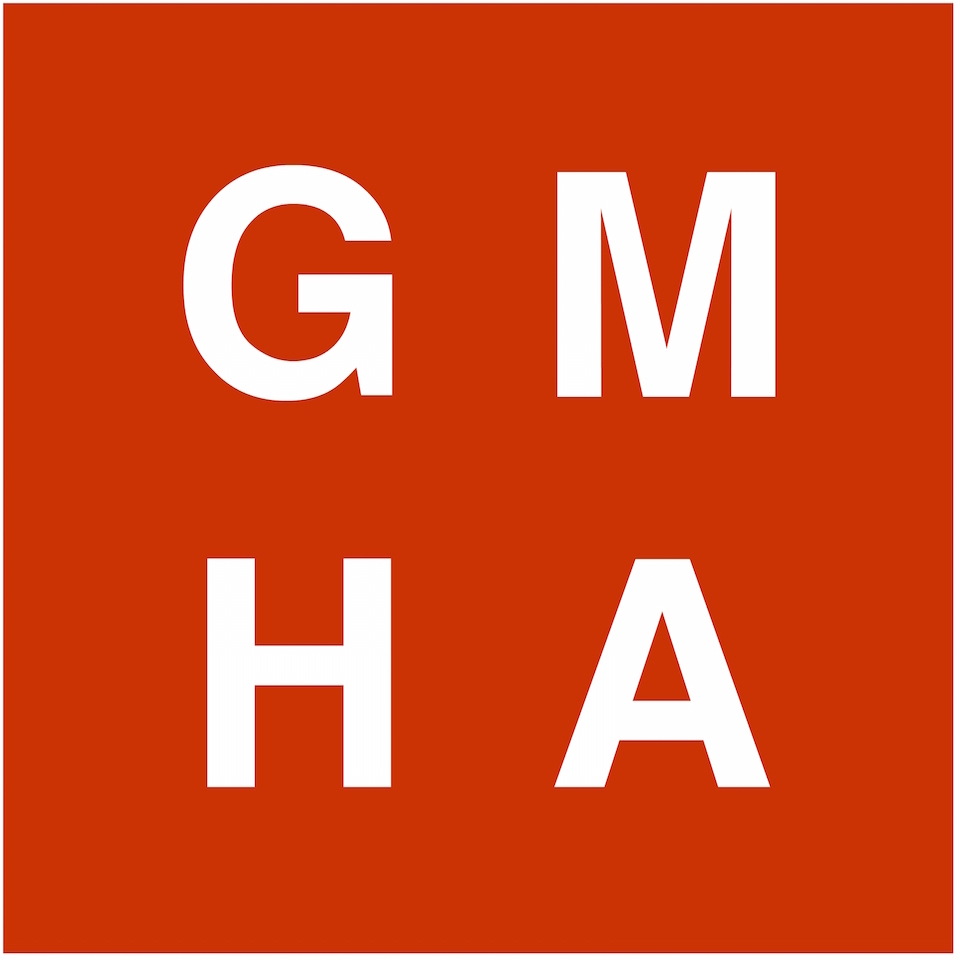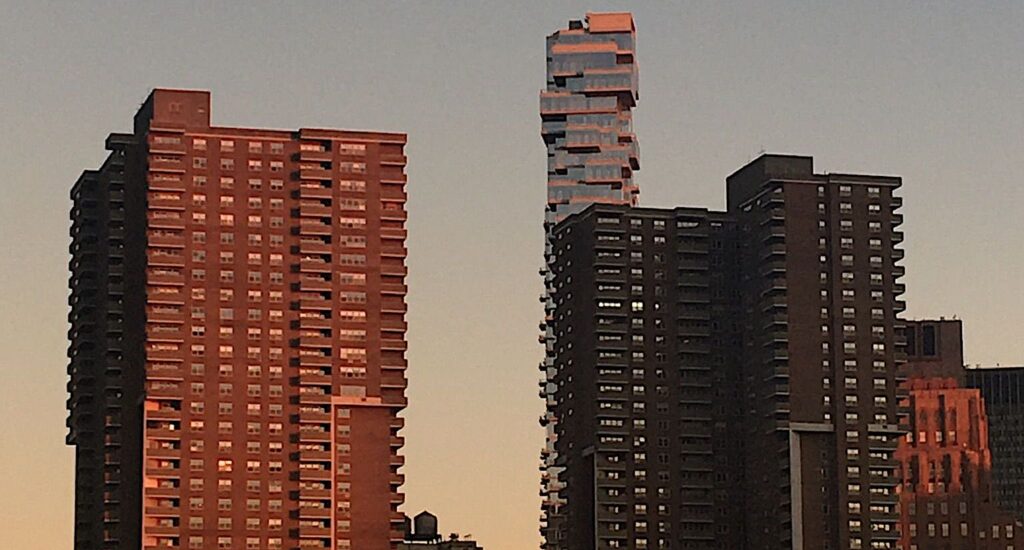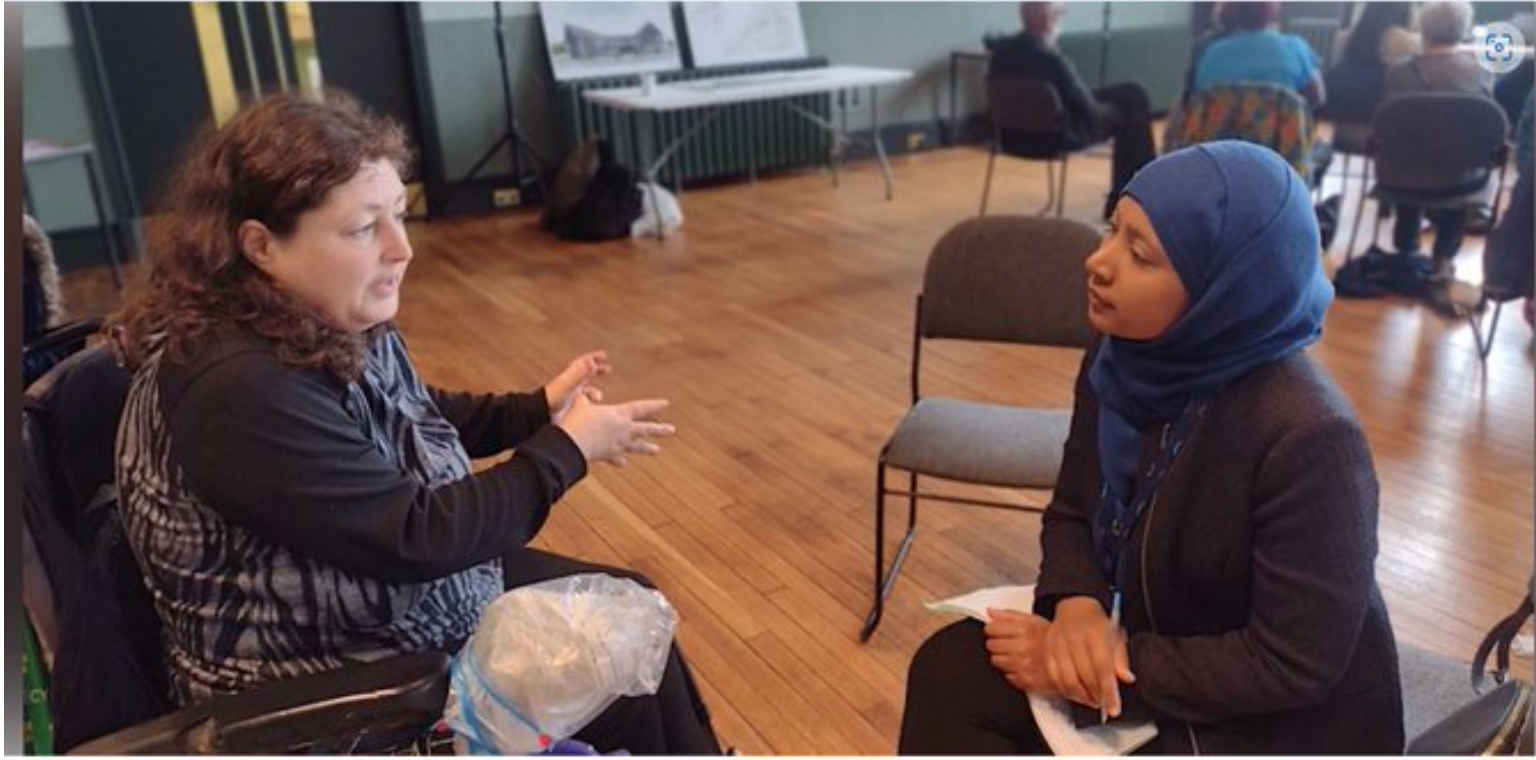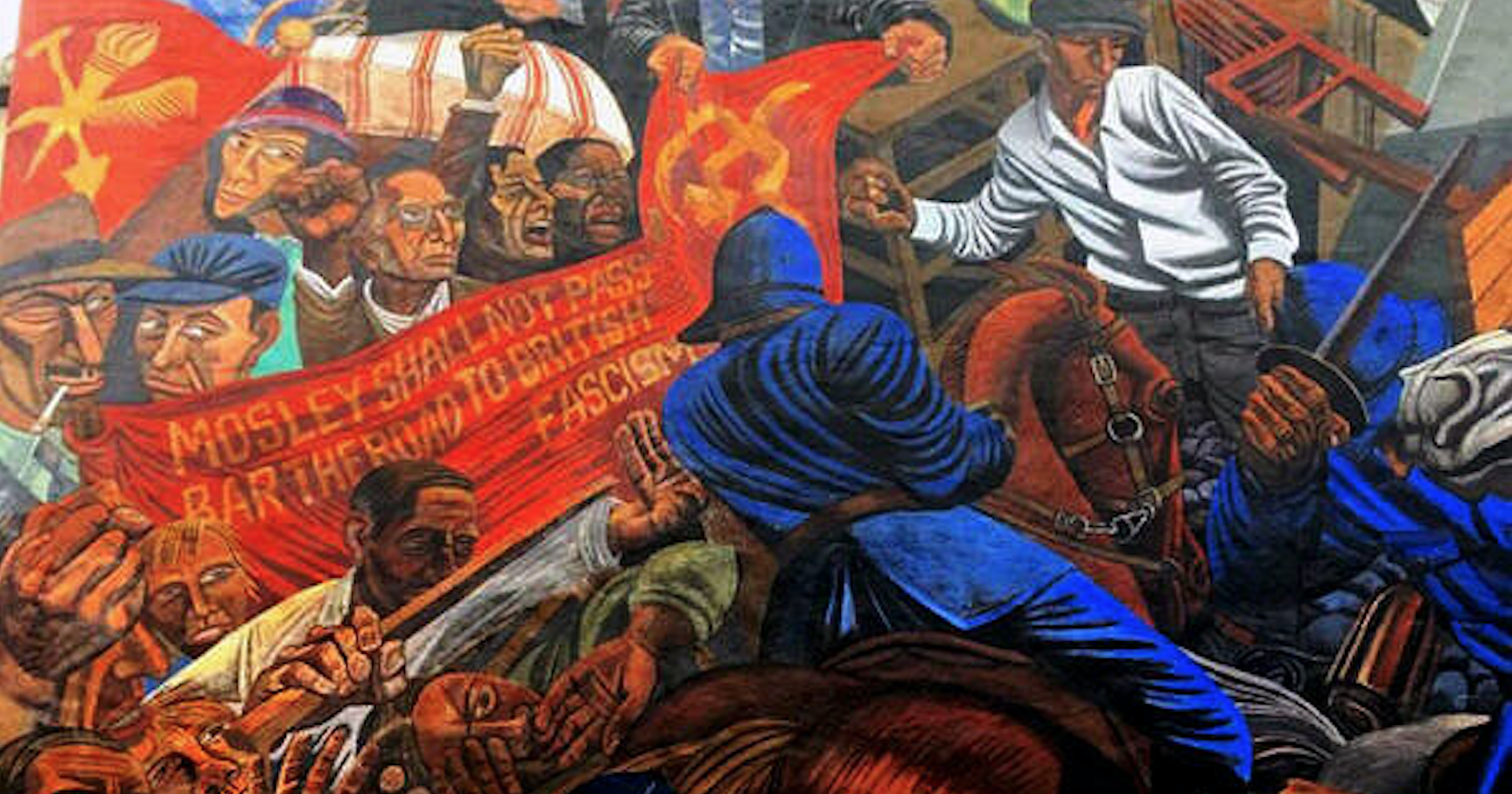By Lily Gordon-Brown (@lilygbrown)
On a recent trip to New York City (NYC), I hoped to gain an insight into how the deep-rooted financialisation and diminished affordability of the city compares to the happenings on this side of the Atlantic. More so, I was excited to see how the growing housing movement across the city was responding. Lucky then, that during my visit, the City Council’s Progressive Caucus was holding a rally to introduce their new agenda.
Crossing the Brooklyn Bridge on a surprisingly (unnervingly?) warm October morning, I headed over to City Hall to meet my friend Jakob, who sits on the board of East New York Community Land Trust. We had a brief catch-up and exchange of words regarding Truss’ short-lived premiership, the state of NYC City Council and the housing landscape across the city. Jakob also equipped me with the necessary context surrounding the Progressive Caucus and their agenda, and how they are gearing up to persuade the Council at large to pass their varied but certainly allied motions.
A sentiment of excitement surrounded City Hall as we arrived. Once we got through the quintessential and a little invasive NYC security system (bag in a tray, tray on conveyor belt—yes, even despite this being an outdoor rally), we joined the groups already positioned on City Hall steps, which included community land trusts, environmental and housing campaigners, the Fortune Society and the New Economy Project, to name just a few. City Council members made their way out and prepared themselves to rally the crowd around their new agenda.
The Agenda
The agenda looks not only to reverse current trends but to transform the state of the city along the lines of ownership, incarceration, and the climate crisis. Whilst I will focus on key three acts which relate to land and property ownership (namely the Community Right of Purchase; an NYC landbank; and the disposition of City property), it is worth briefly attending to some of the other key issues of the day, and the moving words that were spoken.
One of the key issues occupying the agenda relates to incarceration and state violence—specifically, the severe mental and physical consequences of solitary confinement, and the need to abolish it. We heard from a woman who’d spent over 1000 days in solitary confinement, describing the intense, dehumanising nature of such violence, sombrely noting “I will never be the same again”. This agenda item directly confronts Mayor Eric Adams’ pledge to retain the use of ‘punitive segregation’ within incarceration facilities. The Mayor has come under widespread scrutiny given that “17 detainees have died this year, some of whom have been in solitary confinement”. Moreover, closely tied to the manifestation of what Angela Davis has termed the Prison Industrial Complex, the agenda also pledges to abolish the ‘criminal gang database’ created and employed by the NYPD and acts as a tool of predetermined discrimination against criminalised, marginalised communities across the city; one speaker told us, “you will likely be named on the database for just being here today and, in turn, being associated with me”.
In a further effort to release the city from the stranglehold discriminatory practices prior to, during, and after incarceration, the agenda proposes the ‘Fair Chance for Housing Act’, which would remove a landlord’s right to deny housing to individuals on the basis of criminal history (a practice that has no time constraints, i.e., an arrest made 50 years prior can still be used as a mechanism for denial). Those with a criminal record or recently released from prison are far more likely to endure homelessness, echoing the homelessness crisis currently being witnessed across the UK. A report published by Crisis in Scotland found that ‘1,822 homeless applications were recorded as having been from people leaving prison in 2018/1922’. Further, it highlighted four groups which face particular barriers: ‘remand prisoners and those on very short-term sentences, women, young people, and those who were homeless on entering prison’. By drawing these parallels, we can see that such intentionally exclusionary practices embedded in the housing system are not confined inside borders but experienced globally. This only reinforces the need for a discussion around how we can move toward an abolitionist future.
Lay of the Land
The price of land, and in turn the price of housing, has skyrocketed in New York in recent decades. This has filled the pockets of real estate developers who have seen their ‘property values almost triple over the last twenty years’. Of course, like in any city, with intense development comes displacement. This is a story in New York which stretches back to the 1920s, when ‘the architects of the RPA began building office space in downtown Manhattan at breakneck speed’. Reflecting similar paradigms to urban centres in the UK throughout the second half of the twentieth century, New Yorkers experienced various phases of rezoning, deindustrialisation and subsequent social cleansing. Such trends, however, did not materialise by accident. Rather, they were engineered by the intense speculative practices that have come to dictate how once public or common land is used and valued.
Such developments have not come without community resistance. From tenants’ unions, to the Harlem rent strikes of 1963-4, to the direct action undertaken by groups like ACT UP, and the establishment of Community Land Trusts (CLTs), grassroots movements have employed a host of tactics in a ploy to shift the tides of exorbitant development, real-estate hegemony and community displacement. It is in this context that we can better understand the formation of the Progressive Caucus agenda. The emergence of new legislative proposals is not simply the outcome of the discriminatory practices inherent to the property boom, but the pressure put on policymakers through unwavering community resistance.
Specifically relevant to the agenda points I am about to discuss is the evolution of the Community Land Trust movement in New York, which I have written about extensively here. One of the key actors in recent years has been the East New York Community Land Trust, whose members were out in droves at the rally. Established in 2020, East New York CLT define their mission as:
To protect, stabilize and expand the stock of affordable homes, locally-owned small businesses and green spaces in East New York and Brownsville for the benefit of low- to moderate- income, black and brown residents. The CLT exerts control over the built, social and natural environment through community organizing, education, and property ownership.
They, alongside other radical CLTs across the city, have undoubtedly had a part to play in the establishment of the three key agenda items pertaining to landownership across the city, namely: Land Disposition, the Land Bank and Community Right to Purchase.
- The Land Bank:
This word may cause a collective quiver on the part of readers on this side of the Atlantic, given that “landbanking” in the UK usually refers to a practice whereby developers halt any actual development of the land until it appreciates in value and, therefore, the most profit can be extracted from development and subsequent sale. The fact that volume housebuilders across the UK own so much of our land, which will most likely be reserved for expensive private housing, should concern us all. However the Land Bank referred to in this agenda is somewhat different in nature.
The Land Bank, brought forward by Council Member Gale Brewer, proposes that NYC City Council establish its first ever Land Bank, ‘which would be tasked with acquiring, warehousing and transferring real property to develop, rehabilitate and preserve affordable housing.’ The Bank would look to use or buy available properties/vacant plots and then work with CLTs to build more genuinely affordable and accessible housing across the City (it is worth noting that 1459 vacant properties owned by the City are currently sitting empty). This would likely grant CLTs across the City access to more funding and to land which might have otherwise been left empty or unused. The institution of a land bank, following in the footsteps of other cities across the US such as Cleveland, would thus be a vital step for the CLT and community development movement, particularly for CLTs who have struggled with accessing funding for purchasing land from private developers and land-holders, who tend to charge unattainable rates. It also reflects changing nature of state intervention, looking to divert funds away from capital and into the hands of the community.
- Community Opportunity to Purchase
The next agenda item which might hold some sway when it comes to how land is distributed across the city is that brought forward by Carlina Rivera: the Community Right to Purchase Bill. This (in part) mirrors the Scottish government’s Community Right to Buy policy, enabling communities in Scotland to ‘apply to register an interest in land and the opportunity to buy that land when it comes up for sale’. In a similar vein, the Community Opportunity to Purchase would entail a Local Law which would give ‘qualified entities a first opportunity to purchase and an opportunity so submit an offer to purchase certain residential buildings up for sale.’ Furthermore, these entities would ‘have the opportunity to submit the first offer and match any competing offers for the property.’ This right of first refusal would see the likes of CLTs and other community development models acquire a rare advantage in the development process and similarly to the point above, would hopefully be tool for the advancement of genuinely affordable housing for groups such as East New York CLT, and New Yorkers more widely.
- Land Disposition
Closely aligning with the above is the ‘Disposition of Real Property in the City’ Bill, whose prime sponsor is Lincoln Restler: ‘this bill would require that when the city disposes of land for affordable housing, or for any other public use or purpose, it prioritize not-for-profit developers and community land trusts’. Once again, this is an evident shift toward a fairer distribution and ownership of land across the city, prioritising groups who are not interested in extracting profit from housing, or merely treating it as a tradable asset, but rather building a more just housing system.
Closing Thoughts
It is worth noting here that the US does not possess as strong a history of public housing as the UK. Whilst there have been various efforts to introduce more public housing across America, as well as persistent demands throughout history by the likes of the Black Panthers, the NAACP, the labour movement and women’s groups, public housing has struggled to find its place in the US. Reflecting this is the fact that the US Department of Housing and Urban Development noted that in 2020, there were 1 million public housing units in America; that compares with an estimated 4.4 million social homes in the UK. And whilst the current state of UK ‘public’ housing is nothing to shout about, given the scales of each country, the figures are somewhat surprising. In light of this, CLT models and ‘non-profit developers’, which are certainly not without their faults, are one of the few vehicles for the delivery of affordable housing in cities like NYC.
These three items reflect the changing position of City Council members when it comes to the distribution and ownership of land across NYC. Whilst there might be some shortcomings in the agenda, and we must await any decisions made by full Council as to whether any of the agenda items will actually be voted through and become legislation (and how legislation translates into actual change), it was certainly refreshing to see local state politicians listening to and working in solidarity with local community groups and activists. If any of these agenda items were to pass, it would certainly loosen the grip the housing crisis has over New Yorkers, 56% of which currently spend ‘more than one-third of their income on rent’.
The agenda is thus comprehensive in its aims, looking to instil structural change in the intersecting systems of landownership, housing, the climate crisis, and incarceration. These respective changes might occur at different speeds, with some more palatable to the public at large than others, but we must continue to demand full-scale transformation. The redistribution of ownership will be rendered redundant in future if our land becomes increasingly uninhabitable owing to the continuation of carbon-intensive, profit-driven endeavours. And with regards to punitive incarceration, as Davis tells us, the prison system evolves alongside ‘corporate involvement in construction, provision of goods and services and use of prison labour’; in fact, ‘the prison has become a black hole into which the detritus of contemporary capitalism is deposited.’
Thus, we must continue to acknowledge the intersecting nature of these systems and, in turn, expand our imagination to a world whereby genuine liberation and transformation is possible. This won’t merely transpire inside the walls of parliament, congress and city councils, but in our communities and out in the streets.
Lily Gordon-Brown is a graduate housing researcher, a member of Living Rent and a regular contributor to GMHA.
14 December 2022





